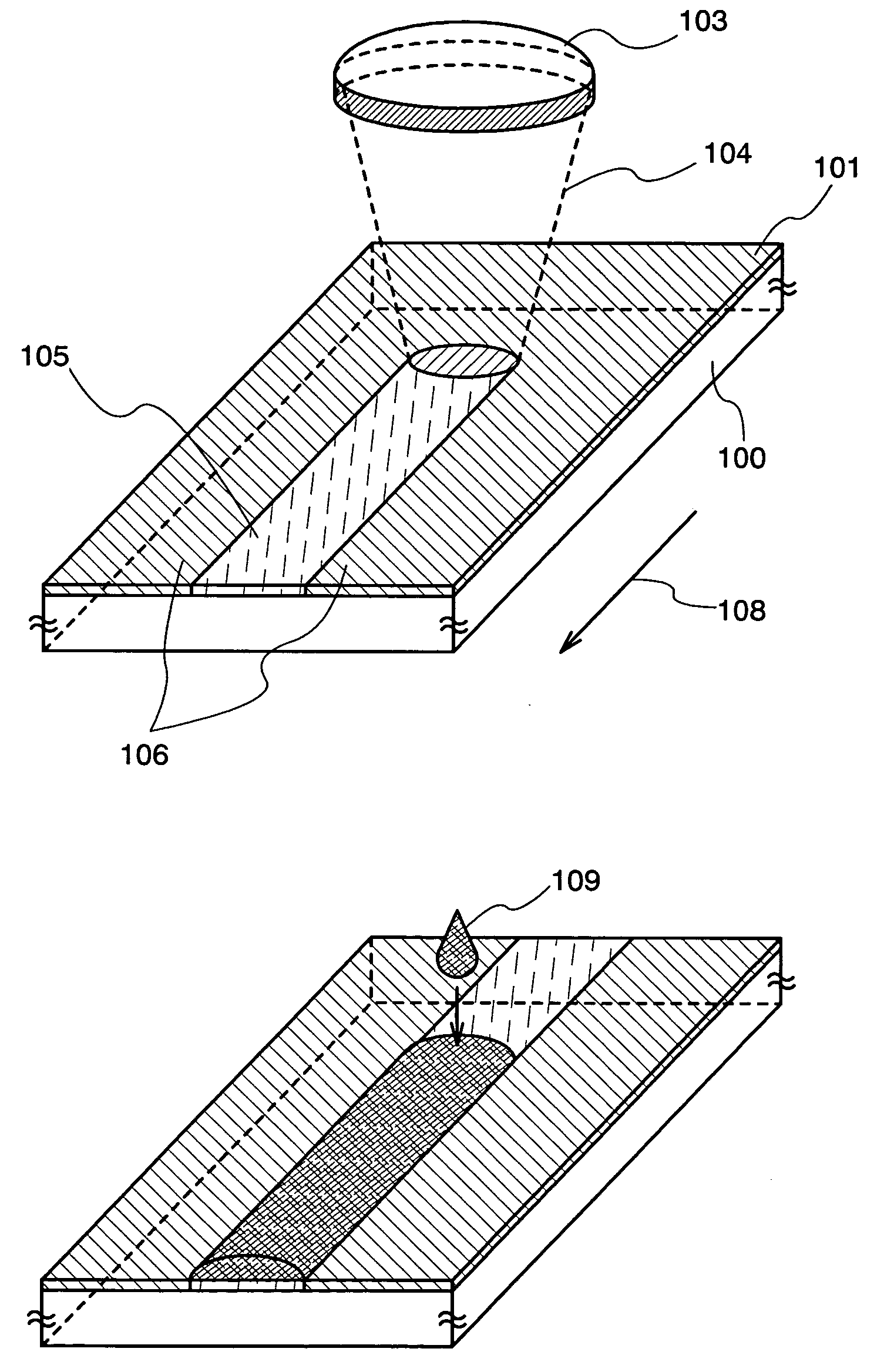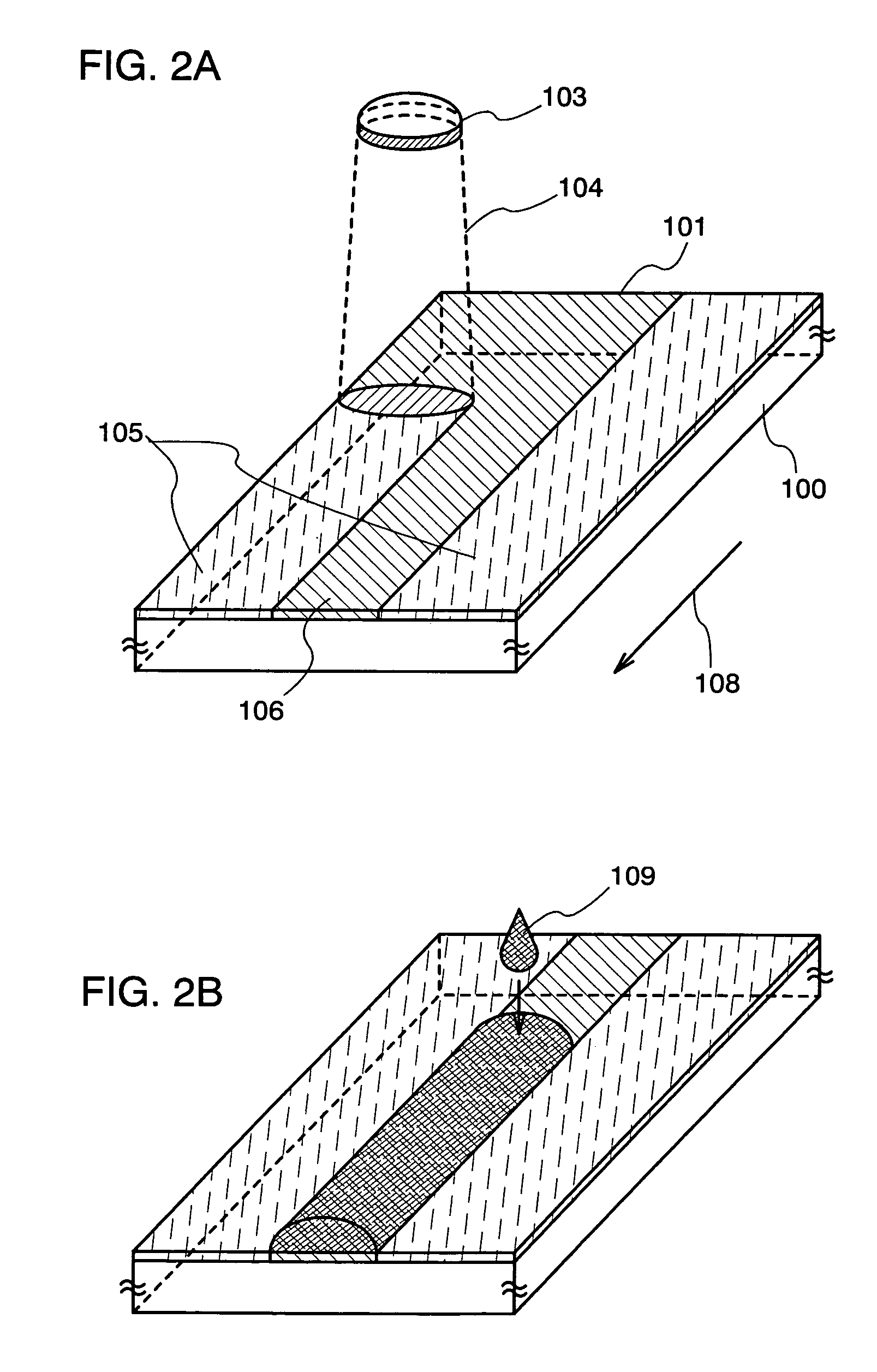Method for manufacturing wiring, thin film transistor, light emitting device and liquid crystal display device, and droplet discharge apparatus for forming the same
a technology of light emitting devices and droplets, which is applied in the direction of static indicating devices, physical/chemical process catalysts, instruments, etc., can solve the problems of difficult to form a small wiring in width, difficult to narrow a line width (simply referred to as a width) of a wiring, and difficult to draw a continuous line in a desired region. , to achieve the effect of easy control of position
- Summary
- Abstract
- Description
- Claims
- Application Information
AI Technical Summary
Benefits of technology
Problems solved by technology
Method used
Image
Examples
embodiment mode 1
[Embodiment Mode 1]
[0051] A specific method for manufacturing a wiring is described in this embodiment mode.
[0052] As shown in FIG. 1A, a photocatalytic substance 101 is formed over a region 100 where a wiring is to be formed. The photocatalytic substance can be formed by a dip coating method of a sol-gel method, a spin coating method, an ink-jet method, an ion plating method, an ion beam method, a CVD method, a sputtering method, an RF magnetron sputtering method, a plasma spraying method, or an anodic oxidation method. In addition, the photocatalytic substance can be formed by mixing and melting a salt of a constituent element, in the case of a photocatalytic substance made of an oxide semiconductor including a plurality of metals. A solvent may be baked or dried when it is necessary to remove the solvent in the case of forming the photocatalytic substance by an application method such as a dip coating method or a spin coating method. Specifically, it may be heated at a predeterm...
embodiment mode 2
[Embodiment Mode 2]
[0076] The case of using an oil (alcohol) based solvent as a solvent of a conductive material is described in this embodiment mode.
[0077] A photocatalytic substance 101 is formed over a region 100 where a wiring is to be formed as described in Embodiment Mode land as shown in FIG. 2A. Subsequently, light is converged by using an optical system to selectively irradiate with light. For example, light irradiation is selectively performed by converging light 104 with a lens 103 and relatively moving TiO2 and the light. For example, the photocatalytic substance 101 may be moved in a direction of an arrow 108. Accordingly, an irradiation region 105 and a non-irradiation region 106 can be formed. Then, TiO2 in the irradiation region 105 shows an oil-repellent property.
[0078] Thereafter, a dot 109 is discharged from above the non-irradiation region as shown in FIG. 2B. An oil (alcohol) based solvent is used as the solvent of the conductive material in this embodiment mo...
embodiment mode 3
[Embodiment Mode 3]
[0085] An example of forming a thin film transistor by using a method for manufacturing a wiring described in the above embodiment mode is described in this embodiment mode. Note that TiO2 is used as a photocatalytic substance.
[0086] First, a base film 201 is formed over a substrate 200 having an insulating surface (over an insulating surface) as shown in FIG. 3A. A glass substrate such as barium borosilicate glass or aluminoborosilicate glass, a quartz substrate, a stainless steel substrate, or the like can be used as the substrate 200. Although a substrate made of a flexible synthetic resin such as plastics typified by polyethylene-terephthalate (PET), polyethylenenaphthalate (PEN), or polyeter sulfone (PES) or acrlyic generally tends to have a lower heat resistance temperature compared to other substrates, it can be used as the substrate 200 as long as it can withstand the process temperature in the manufacturing step.
[0087] The base film 201 is formed in ord...
PUM
| Property | Measurement | Unit |
|---|---|---|
| contact angle | aaaaa | aaaaa |
| contact angle | aaaaa | aaaaa |
| contact angle | aaaaa | aaaaa |
Abstract
Description
Claims
Application Information
 Login to View More
Login to View More - R&D
- Intellectual Property
- Life Sciences
- Materials
- Tech Scout
- Unparalleled Data Quality
- Higher Quality Content
- 60% Fewer Hallucinations
Browse by: Latest US Patents, China's latest patents, Technical Efficacy Thesaurus, Application Domain, Technology Topic, Popular Technical Reports.
© 2025 PatSnap. All rights reserved.Legal|Privacy policy|Modern Slavery Act Transparency Statement|Sitemap|About US| Contact US: help@patsnap.com



